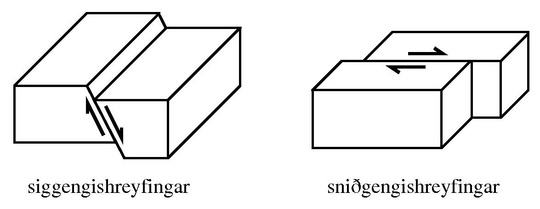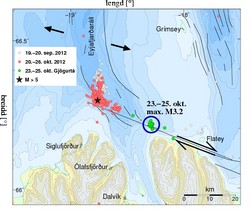Further information on the seismicity in Northern Iceland
Seismic activity at Eyjafjarðaráll is continuing although it has slightly decreased since yestarday evening. On 25 October, the largest events in the source region of Sunday's M 5.6 earthquake were M 3.6 at 03:42 and M 3.2 at 07:47. Since the afternoon of 23 October, a new cluster of earthquakes has occurred about 5 km north-northwest of Gjögurtá on the intersection of the eastern end of Eyjafjarðaráll and the Húsavík-Flatey Fault (HFF). The largest events in this region were M 3.1 at 23:38 on 23 October and 3.2 at 22:20 on 24 October (see the map).
Movements on the fault of the M 5.6 earthquake indicate normal faulting (see diagram below), suggesting that the earthquake was related to spreading of a depressed block of seabed, known as graben. Analysis of the source mechanisms of the earthquakes NNW of Gjögurtá shows signs of horizontal movement. Although such strike-slip events (see diagram below) are common for this region, they seem to indicate that seismicity in Eyjafjarðaráll has affected the stress field on the western part of the HFF, and some of the recent events are, indeed, located on this fault. Although seismicity on HFF fault is commonplace, developments on Tuesday afternoon highlight the possibility of a large earthquake being triggered by stress changes.
In response to this development, the scientific advisory board of the Iceland Civil Protection met on 24 October. At this meeting it was agreed that the Civil Protection's alert level should be increased to ‘uncertainty' stage. This is a precautionary step because it is unknown how close the HFF fault system is to failure. The possible stress changes on the HFF, due to the ongoing earthquake swarms, could bring it closer to failure or trigger a larger earthquake on the fault. The timing of any large earthquake cannot be predicted, so the ongoing seismicity should be used as a reminder that large earthquakes should be expected in the region within the next few decades. See also previous article.
Scientists at the Icelandic Meteorological Office and the University of Iceland are monitoring the situation activity closely, and they are in regular contact with the Civil Protection agency.
On the web page of the Icelandic Civil Protection agency, information can be found on how to prepare and respond to earthquakes and ICE-SAR has a video showing how to respond to earthquakes.
In the diagram below, normal fault can be seen on the left and strike-slip to the right.





